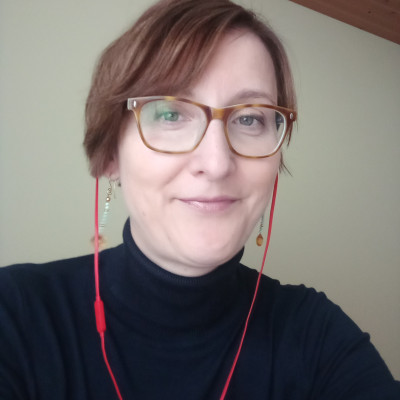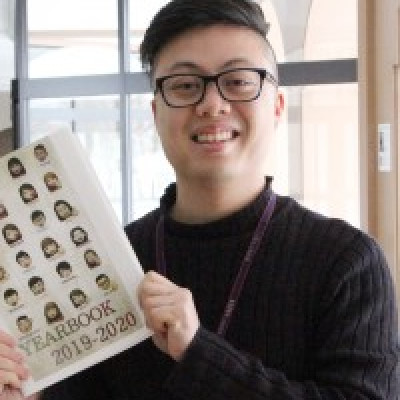Sessions / Location Name: Zoom F
Virtual Location
Virtual: You cannot enter virtually via this page. Click on the titles of individual presentations or go to the Live Page
Teachers' Attitudes and Perceptions on Implementing Mobile AR for the Teaching of Italian as a Foreign Language #3025
Augmented Reality (AR) is an emergent technology that is revamping the educational environment (Lee, 2020). Despite the plethora of advantages that AR has demonstrated in a number of disciplines, its implementation for second and foreign language teaching is still limited and it requires further investigation (Pegrum, 2021). Although AR offers the opportunity for the creation of linguistically and culturally authentic domains, the majority of educators are unfamiliar with this emergent technology. Therefore, the role of teachers as designers and facilitators it is still a critical factor (Parmaxi, Demetriou, 2020). On the other hand, the most explored target languages are English and Chinese and although less commonly taught languages are being investigated, the study of AR for the Teaching of Italian as a Foreign Language (TIFL) is limited to one empirical research (Cervi-Wilson, Brick, 2018). Against these backdrops, the researcher implemented an Action Research study, focussing on the perceptions of IFL teachers in Argentina. The investigation aimed to highlight the perspective of educators when engaged in the process of designing and implementing AR activities for adolescent students through a mobile AR tool, in a context where economic and technological resources can be limited. Data collected are presented and initial findings of the pilot study are discussed. In line with other researches (Chen et al., 2020; Taskiran, 2019), the analysis showed that according to the perceptions of teachers, AR has the potential to enhance student motivation, since it enables the delivery of language and cultural contents with an engaging and meaningful approach for adolescent students. However, although teachers’ positive attitudes towards AR implementation, the research highlighted the need of long-term, ongoing technical training for teachers, since it is crucial to support an effective integration of the technology in classroom. Moreover, the initial findings highlight the need for an open-source, code free, mobile AR platform specifically designed for language teachers. Becoming equipped with skills and tools to integrate AR in language teaching and learning, educators can indeed customise this emergent technology and avoid the situation where AR learning design is mainly managed by information technology specialists, that ignore students’ needs and have a limited understanding of effective pedagogies.
Nation’s Four Strands and Digital Language Pedagogy with ZenGengo #3255
In recent years, the move toward blended and hybrid forms of language learning has lead many teachers to re-evaluate their digital toolsets. Language teachers in particular need not only a reliable set of tools but also a solid pedagogical framework within which these tools can be put to use. As the old saying goes – it’s not just the technology, but what you do with it that counts.
Renowned linguist Paul Nation argues that a well-balanced language course should consist of four strands: meaning-focused input, meaning-focused output, language-focused learning, and fluency development (Nation, 2007).
In this presentation, the developer of ZenGengo, a web-based language teaching and learning platform, will demonstrate how the platform can be used to quickly and easily create activities that correspond with each of Nation’s four strands.
The presenter will show how by using ZenGengo, language teachers can not only create more effective and engaging activities for their learners, but also manage their own workloads more efficiently, and ensure that students can always access their course materials whether face-to-face, fully online, or somewhere in between.
Nation, P. (2007). The four strands. International Journal of Innovation in Language Learning and Teaching, 1(1), 2-13.
Making Life Easy With One Master Spreadsheet #2940
This practically-oriented presentation will demonstrate how to resolve the following matters using one spreadsheet to keep everything a teacher might need available within less than three clicks:
Language teachers often teach two or more sequential classes. Their students often have to quickly go to another lecture too. There are a few golden moments in between where a one-to-one exchange is possible for questions and communication. Such exchanges usually involve inquiries about given assignments or prior grades. Without an easy and timely way to answer such queries—all the while preparing for the next class—simple questions can become stressful for all concerned.
Participants in this session should have a good idea how to use a spreadsheet to record everything a university lecturer needs in one place, especially (1) student attendance, (2) grades & assignments.
An Open Table for Using Dungeons & Dragons with University EFL Students at a Foreign Language Resource Center #2944
Tabletop role-playing games (TTRGPs) are growing in importance to the culture of the English-speaking world. 2022 marks the 10th year since the 5th edition of Dungeons & Dragons was introduced, with the game's growth and profitability soaring to record heights at a point when most TTRPGs would have reached market saturation and the end of its commercial viability (Abadia, 2021a). This record success has encouraged Hasbro to push Dungeons & Dragons further into the entertainment space (Abadia, 2021b), resulting in representations of Dungeons & Dragons in TV (Lawrence, 2021), movies (Ashton, 2021), and video games (Wilde, 2021). Given the continuing media saturation of Dungeons & Dragons into the English-speaking world, teaching the language and culture of TTRPGs is increasing in importance as a worthwhile area of language teaching. In addition, the shared storytelling nature of Dungeons & Dragons naturally lends itself to positive relationship building (Shea, 2019) through creating an environment requiring communication, a necessary component for language acquisition (Long, 1981). In this Show & Tell presentation, the presenter will describe the process of creating a Dungeons & Dragons tabletop role-playing game club at the Global Education Research Center of a large university in Tokyo. After briefly covering how the game of Dungeons & Dragons has become more prevalent in the English-speaking culture, the presenter will describe the principles used to orient the club as a language learning environment: namely, the after-school enrichment program model of education and open-table design principles (Alexander, 2011, 2016a, 2016b, 2016c). Following this, the presenter will outline the online resources, including blogs, podcasts, and videos that inspired the club's structure and content. Next, the presenter will describe the process of navigating the administration structure of the resource center. Finally, the presenter will describe the reactions of the students who attend.
Spanish Bilingual and EFL Pre-Service Teacher Attitudes Towards Digital Game-Based Learning Considering the TPACK Model #3058
Games play an essential role in our daily life and in our learning, both in nonformal and informal contexts, and the consideration that the only goal of games is entertainment has been overcome. In fact, digital game-based learning (DGBL) can support effective pedagogical methods as long as teachers are given the necessary time, training and tools to implement this approach in their lessons. Nevertheless, the use of DGBL could have not been possible without the evolution of educational technology, whose potential didactic uses and benefits for students’ learning and competences have been widely discussed and demonstrated in the specialised scientific literature. In this context, the link between educational technology and the Technological Pedagogical Content Knowledge (TPACK) model is clear. The TPACK model assumes that the proper use of educational technology is subjected to teachers’ content knowledge, methodological, and digital competences. In the same line, new frameworks related to the TPACK model have been developed in the specific field of digital games. Such is the case of the Technological Pedagogical Content Knowledge-Games (TPACK-G) model, which highlights the importance of teachers’ knowledge about the usage of digital games and their skills to use them for teaching purposes appropriately. Considering the link between the TPACK-G model and the use of DGBL, this exploratory quantitative research examines bilingual and EFL pre-service Spanish teacher perceptions (n = 64) about using digital games in their lessons, paying a special attention to the TPACK model. Responses show a positive attitude towards the potential use of digital games in their future bilingual and EFL lessons. The data presented in this study can be relevant to guide the design of curriculum and training programs, as well as to develop strategies to support and scaffold pre-service teachers’ knowledge and practical implementation of DGBL.
Create your story with Her Story: Digital Game-Based Learning to Foster Creative Writing in English as a Foreign Language #3032
The use of digital game-based instructional strategies has been demonstrated as encouraging students’ learning performances and motivation when learning a foreign language. Moreover, in recent years creativity has been emphasized as a key competence, and has gained considerable interest in many fields of education; however, creativity – and especially creative writing – is not so commonly developed in English as a Foreign Language (EFL) lessons. This study investigates how a digital game, Her Story, was used to promote BA students’ creative writing in EFL in two contexts: University of Lower Silesia, ULS (Poland) and University of Córdoba, UCO (Spain). This study uses the aforementioned digital game, which presents a murder mystery, and presents a creative writing project to provide an authentic learning opportunity through which students are able to develop their creativity, use EFL in a meaningful way, and enjoy while learning. The study participants had an intermediate-advanced FL knowledge (English Level B2-C1, CEFR). There were 17 female and 8 male study participants in ULS, and 22 female and 3 male participants in UCO. The study was conducted from October to December 2021. In this mixed-methods research, the quantitative study includes a pre-test and a post-test to explore students’ creativity in both contexts; while the qualitative study aims for the in-depth understanding of students’ creativity considering their own creative stories based on the plot of the game according to the three constructs of Torrence’s model of creativity (originality, flexibility, and elaboration). The results aim to demonstrate how students’ perceptions and writing tasks exhibit creativity, as well as how this type of projects can enhance students’ motivation and engagement in learning EFL.
Virtual Reality for Immersive Student Motivation #3072
Games for motivation have been used tirelessly in ESL. These games are specifically designed as educational tools first and secondary as games. It is the presenter’s intention to show a reverse of this, where a non-educational VR game if used to motivate students, could promote a vision of one’s ideal self, and subsequently motivate one to work toward or become their ideal self. In the article “The Ideal Self at Play: The Appeal of Video Games that Let You Be All You Can Be” (2012) it is shown that highly immersive gaming such as VR was intrinsically motivating to players. The more immersion the game had, the closer the player felt to their ideal self (character). The purpose of this presentation is to show that immersion in gaming has the potential to create an image of an ideal self in the student player which then would motivate the student to imitate and become the ideal self. In the presentation, the presenter will demonstrate that students are increasingly motivated through gaming with results from a Likert Scale survey from 111 first and second-year students in four separate agricultural departments at Akita Prefectural University. Two questions were the focus of this research: 1. Are students motivated in their lives and identify with game characters or game stories? 2. Could gaming be used to inspire students to learn a Foreign language? The students in majority answered that they both identify and are motivated by gaming as well as believe that gaming could be used to inspire learning English as a Foreign Language. To build on this the presenter will use the Self-Determination Theory to explain why students in the survey felt intrinsically motivated by gaming. Finally using virtual reality to demonstrate, the presenter will show that highly immersive VR gaming technology can be incredibly motivating to converge the real self and ideal self in students.
A Study on Implementing Moodle Learning Management System (LMS) into the Classroom #3036
A learning management system (LMS) provides features that support learning activities, for example, on-demand discussions, supplemental textbook modules, quizzes and exams, interactive elements, both available either online or offline. Initially, the idea of augmenting an LMS into a classroom was fixated on complementing course materials to students for easy access (Lyashenko & Frolova, 2013); however, it became evident after COVID-19 that an effective system needed to be in place (Blinov & Esenina, 2020). A sound LMS requires good planning and execution that is well-organized to distribute learning objectives and resources thoroughly. The shift from face-to-face instruction to online learning requires that the classroom environment also be digitized to aid in the instruction and support of teachers. While there are many different academic LMS software available for end-users, this presentation will focus on the learning management system Moodle, its standard features that have helped support the presenter's classroom both face-to-face and online remote learning, its advantages and improvement over other comparable systems, and some of the challenges that are presented. Finally, monitoring the future of Moodle and e-Learning systems beyond COVID-19 will be discussed. It is the presenter's hope that participants can find LMS software as a long-term valuable augmentation to their classrooms, both in-person and online.
A multilingual educational platform of disaster preparedness for foreign residents in Japan #3034
Japan is a country frequently hit by natural disasters such as earthquakes, tsunami and volcanic eruptions. Language barriers mean many foreign residents of Japan are unable to receive as much training in disaster preparedness skills as are Japanese citizens, thus how to deliver disaster prevention knowledge and skills in easy-to-understand language and make the educational recourses available for as many foreign residents as possible is the key for this project. Funded by Japan Society for the Promotion Science (JSPS), the authors have developed a multilingual educational platform of disaster preparedness, as well as a smart phone application for foreign residents in Japan to gain knowledge and learn skills of disaster preparedness. The platform currently consists of three languages: Japanese, English and Chinese. However, considering that a larger number of foreign residents are not fluent Japanese speakers nor skillful English speakers, use of the three languages for the platform were based on the following must do principles: (1) The languages must target not only native speakers, but also non-native speakers. (2) Any disaster mechanism, phenomena and precautionary measures must be introduced in small chunks instead of long articles, and overly detailed and complex descriptions must be avoided. (3) Vocabulary, grammar and sentence length must be limited to basic levels. (4) Illustrations to help readers’ understating must be included in every text passage. (5) The platform must be user-friendly to both PC and smartphone users. The platform is freely open to foreign residents in Japan and feedback is continuously sought and received by the authors. This paper will analyze the objective feedback data from international users as well as the subjective log data obtained directly from the platform. (This work was supported by JSPS KAKENHI. Grant Number: 19K03002)
Self-directed Student Learning in Virtual Reality: Affordances and Implications for Higher Education Teachers #3090
The two presenters co-explored the educational affordances of VR with a group of five university students in Japan who met online from April 2021 until January 2022. The research was a small-scale scoping study to investigate three types of VR. In the first stage, the participants used Oculus Quest 2 Head Mounted Displays (HMDs) in the Engage collaborative VR space. After a period of initial game-like training on how to use the HMDs the five students were asked to review VR apps that were connected to their academic discipline. Results showed a large number of positive effects of working in VR including high levels of engagement and low anxiety levels: students really enjoyed the games and game-like apps that they chose and the use of avatars made working in the VR space playful and enjoyable. However, on the negative side, almost all participants suffered some kind of ‘cybersickness’. For this reason, it was decided to move from HMDs to the Mozilla Hubs web-based browser. In this second stage participants created their own VR rooms in which they taught each other about one aspect of their academic field. Examples included an explanation of infinity and one on the role of art in propaganda. In the third stage, the participants used 360-degree cameras to take photos and videos of a location of their choice. They then populated these with various embedded features using the ThingLink application to create virtual tours which could be uploaded and shared. This presentation will discuss the potential of the three VR types for language learning in a self-directed context. It will also describe the challenges to such a mode of teaching which include technical issues of Wi-Fi, computer processing power, training in the VR environment, and ethical and health concerns.
Interaction Frequency and Pedagogical Outcomes in Digital Game-Based Learning Curricula #3029
Currently there is a vast selection of off-the-shelf commercial digital games with varying gameplay mechanics which have the potential to impact digital game-based learning (DGBL) curricula. We believe that careful consideration must be given to both the type of game and the method of in-class implementation in order to ensure the best pedagogical outcomes when using DGBL tools. Along these lines, it is imperative that DGBL curricula carefully gather data on both the hypothesized pedagogical impact that a digital game title elicits as well as on student participation methods in order to better inform any future in-class use of the same digital game title. This paper presents the results of a pilot study looking at how the grammar/syntax-based puzzle game Baba Is You (Hempuli, 2019) affected student performance on English language word-order tests in university-level EFL courses. The results of these word-order tests are compared to a control group who did not interact with the game Baba Is You. Although there was no statistically significant improvement in scores observed in the pre-/post-test data from both treatment and control groups, data gathered from the treatment group on the frequency of interaction with the gameplay mechanics revealed a stronger post-test correlation between interaction frequency and test scores relative to pre-test correlations. These data may suggest that the more the participants interacted with the gameplay mechanics, the higher the test scores they achieved on the post-tests. The implications of these results may suggest that the observed pedagogical outcomes may be influenced by in-class implementation methods which encourage a higher interaction frequency with the gameplay mechanics.
Speech recognition: overview and accuracy #3119
Speech recognition and synthesis are perhaps the last stage in interface technology. For the language learner, the ability to speak to a device that can simultaneously play different roles and accents (female, male, old, young, Irish, Scottish, New Zealand, Fijian, Canadian, US etc.) is opening up speaking opportunities for L2 learners. However, the machine learning engines that allow such interactions are somewhat of a black box. In this study supported by a JSPS Kakenhi Grant as part of a Japanese MEXT Grants-in-Aid for Scientific Research, we look at the accuracy and use of such systems, and this presentation will give an outline of how the technology works, its future, and the preliminary results of this ongoing study.
AI-Powered Digital Lessons for Global English Learners #3254
Anyone who has ever tried to learn a foreign language knows that it is not easy. It takes a lot of time, a lot of energy, and a lot of determination. In fact, the time required for Japanese speakers to obtain proficiency in English is estimated to be over 2,500 hours of intentional study (Inagaki, 2005). Scholars such as Nation (2007) also highlight the importance of "time on task", and argue that in order to learn to read and write you have to read and write a lot. In the 21st Century, non-native speakers of English are in the majority, and English is used as a global Lingua Franca. This means that English learners should be engaging with and producing English as a global language. And as we all know from our experiences during the pandemic, students need to be able to access learning content and activities whether face-to-face, fully online, or anywhere in between. Bearing these facts in mind, the speaker introduces "ZenGengo Academy", a new AI-powered content solution for Japanese learners of English at the A2 to B1 CEFR level. ZenGengo Academy contains one-hundred lessons of effective and engaging content, from Mario to the Titanic, from Flamingos, to Sustainable Development Goals. Each lesson contains five interactive activities that require students to both comprehend and produce English in a variety of forms. Teachers can easily keep track of how long students have spent studying, and how well they have understood the content. Supplementing classroom-based study with ZenGengo Academy increases time-on-task and provides learners with much-needed exposure to global Englishes.
Inagaki, S. (2005). How Long Does it Take for Japanese Speakers to Learn English?. 言語と文化, (4), 19-29. Nation, P. (2007). The four strands. International Journal of Innovation in Language Learning and Teaching, 1(1), 2-13.
The Four Pillars of Team-Based Learning (TBL): Where Does CALL Fit In? #3089
This short talk centers around how common Google products (Docs, Sheets, Forms, Sites) and other online tools are being used to facilitate and enhance a TBL approach to content and language integrated learning (CLIL) at the tertiary level in Japan. TBL has been found to bolster both content and language knowledge and skills in this context, while at the same time increasing learner engagement. The talk starts with a short introduction to the four pillars of (1) strategically organized teams, (2) readiness assurance tests, (3) application of foundational knowledge, and (4) peer assessment. This will be followed by examples of how the digital tools have been used to facilitate collaboration, peer and teacher feedback, content delivery, and learning assessment in both online and face-to-face versions of two CLIL courses: one a large intercultural understanding and communication course, and the other a project-based learning course dealing with the beer industry. The talk concludes with initial findings from a mixed-methods action research project focused on learner engagement and the basic psychological needs of competence, autonomy and relatedness described in self-determination theory.

















